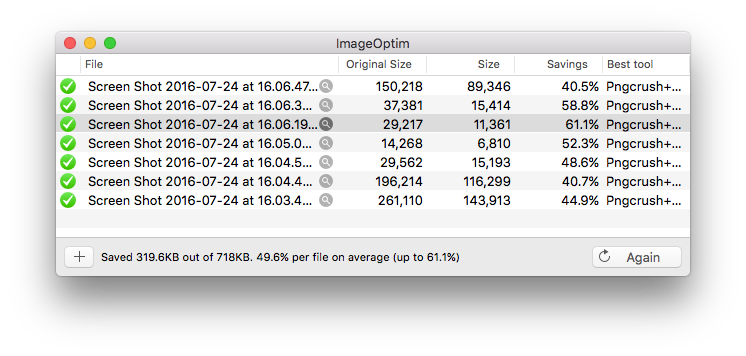
IMAGEOPTIM LINUX INSTALL
There is an alternative for those who don’t have shell access and the ability to install the extra software needed on the WordPress server. It uses jpegtran, OptiPNG/PNGOUT, and gifsicle for compression. This plugin is for those who host their server because you need to be able to install all the Linux commands requirements for the plugin. It has a lot of settings for optimizing the compression. EWWW Image OptimizerĪ WordPress plugin that automatically compresses uploaded images.
IMAGEOPTIM LINUX WINDOWS
By utilizing several Open Source programs like PNGOUT, AdvPNG, Pngcrush, OptiPNG, JpegOptim, jpegrescan, jpegtran, and Gifsicle it has lots of muscle for jpeg compression.įor Microsoft Windows users, there are similar apps, like RIOT, but I haven’t tried it.
IMAGEOPTIM LINUX FOR MAC OS
ImageOptim is a popular (and free) image optimizer for Mac OS X. But if you have to send large photos with the quality of the original still intact, this is the obvious choice.

And it seems like it’s a good match for some smaller images as well. I’ve included lower resolution pictures just out of curiosity. This is a tool primarily for compressing large size images and does a fantastic job of it. JPEGmini is an excellent image compressor application on Mac OS X. I tried to take different kind of images, where some contain a lot of details, and other with less, to see what kind of effect that has on the image compression result. I’m not a big fan of jpeg artifacts, but you could get away with much lower quality setting depending on the picture. I exported all the pictures from Adobe Lightroom 4 as jpg with a quality setting of 80, which is the one I usually use when uploading to my blog, Flickr or 500px. I’m concentrating on testing jpeg files here, and do a followup article later with results for optimizing PNG files. All applications tested claims not to lower the quality of the image. But which one works best for posting images on a website? I was curious, so I took the tools I usually use and put them through the compress photo function. Registered stream wrappers: https,ftps,compress.There are several JPEG image compression tools available that takes a jpeg file and reduces the size of the photo without altering the quality. Wp_upload_dir (basedir): /home/c2390804/public_html/clientes/pelar/wp-content/uploads WP_CONTENT_DIR: /home/c2390804/public_html/clientes/pelar/wp-content Loading image editors: EWWWIO_Imagick_EditorĪBSPATH: /home/c2390804/public_html/clientes/pelar/ Not resuming/scanning, so clearing any pending images in both tables Permissions for /home/c2390804/public_html/clientes/pelar/wp-content/ewww/cwebp: 0755 Permissions for /home/c2390804/public_html/clientes/pelar/wp-content/ewww/jpegtran: 0755 Linux/UNIX style OS, checking permissions home/c2390804/public_html/clientes/pelar/wp-content/ewww/cwebp home/c2390804/public_html/clientes/pelar/wp-content/ewww/pngquant home/c2390804/public_html/clientes/pelar/wp-content/ewww/gifsicle home/c2390804/public_html/clientes/pelar/wp-content/ewww/optipng home/c2390804/public_html/clientes/pelar/wp-content/ewww/jpegtran home/c2390804/public_html/clientes/pelar/wp-content/plugins/ewww-image-optimizer/binaries/cwebp-linux home/c2390804/public_html/clientes/pelar/wp-content/plugins/ewww-image-optimizer/binaries/pngquant-linux home/c2390804/public_html/clientes/pelar/wp-content/plugins/ewww-image-optimizer/binaries/gifsicle-linux home/c2390804/public_html/clientes/pelar/wp-content/plugins/ewww-image-optimizer/binaries/optipng-linux home/c2390804/public_html/clientes/pelar/wp-content/plugins/ewww-image-optimizer/binaries/jpegtran-linux Request uri is /wp-admin/upload.php?page=ewww-image-optimizer-bulkĬhecking/Installing tools in /home/c2390804/public_html/clientes/pelar/wp-content/ewww/ Plugin (resource) content_dir: /home/c2390804/public_html/clientes/pelar/wp-content/ewww/ I leave the log to verify, I looked and found no errors.

All images threw me the following message “Image could not be converted to WebP”. For some reason when I run bulk optimization the plugin does not convert the images to Webp, it only optimizes them.


 0 kommentar(er)
0 kommentar(er)
